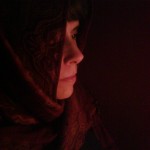
Cultural Daze (Part II)
Last time I checked in, I was still in a state of dazed confusion. But grateful for the disorientation of not knowing and on my way to part two of the celebration of Eid ul-fitr.
My pastors and I had been at a gathering of several thousand Muslims for their prayer service following on the end of Ramadan. We had been invited guests but so far we had not seen our host up close. That it turned out, was not to be.
We trapsed back to the car through the damp grass, relieved when we got in to remove our head scarves. The phone map helped us along some back streets away from the arena to get across town to the next celebration before most of our neighbors. The rain clouds looked threatening, but no drops were falling yet. We took turns recounting what we’d seen and heard in the first hour. We checked phones to catch up with others who could and could not meet us for the next part of the celebration.
When we arrived at the Islamic Center we parked on the street and took our time getting out. We approached slowly on the sidewalk, not sure which was the “sisters’ door.” This time a gracious host came and met us. He directed us to the right door, after we explained that we’d been invited to come by the Imam.
Before going in we thought we’d wait for our fourth companion to join us. She needed a scarf so I got an extra from the trunk which she donned more stylishly that me. Hipster in a head scarf. It’s possible. We entered the women’s section of the mosque and removed our shoes, placing them on shelves designated for that purpose, but located in a very tight space.
We took up places along the wall. And we sat. And we waited. I wasn’t sure if we were going to pray again, or eat, or something else entirely. No one was forthcoming with information. But the room began to fill with women and children.
Then someone appeared with a roll of butcher paper about 18 inches wide. Two women began to roll it onto the floor and cut it into sections. Soon it became evident that these were make-shift tables. With the crowd growing I was wondering how exactly this operation was going to work. The women to our left did not seem to speak or understand English. They did have some food with them. I wondered for a minute if we had tripped up again. Was this was a pot-luck? If so, we were out-of-luck.
The young woman to my right was willing to answer my questions about the henna designs on her hand. Her sister was the artist who painted them there. She seemed shy and didn’t have anything else to say. When I looked around she was gone. Across the room.
Two mothers with a double handful of children eventually settled across from me and one of my pastors. The other paster and church member were further down the wall with several folks between us. A man came to the door and shouted for help from the sisters to get the food into the room.
Styrofoam plates were handed into the room and passed along hand over hand until they were distributed all around. We waited and passed plates along as they came our way. Each plate had a different dish: yogurt cheese, hummus, scrambled eggs with herbs, lamb or beef (I couldn’t tell for sure), a spicy bean dish and pickles and olives. Eventually every paper table on the floor was covered with dishes of food.
We waited again for our hosts to show the way, unsure of when or for that matter how to eat. Our answer came in pita bread. The bread was shared around the room. This was our delivery system of food to mouth: edible utensils! We simply ate from the common dishes. No one had her own plate.
We wondered aloud to each other how it might go if we suggested these arrangements to our Baptist congregation for an upcoming Wednesday night. We agreed that it was not likely an idea that would be widely embraced.
Making connections was our greatest challenge of the meal. Eventually we did so by engaging the children around us. Making faces, asking small questions, talking to moms about their children. Gradually we began make conversation as we tasted the flavors of the day.
Across from me sat a woman with four children (1, 4, 5 and 6) and she told me she had three more older teen aged boys. She also told me she had all the children she wanted while feeding the youngest a bottle. She even handed him over to me for a while. He was not happy to sit in my lap, but howled all the more for his mama.
The conversation level and sound grew louder through the meal. As the food went in more walls seemed to come down. At one point another white euro-american arrived. She had missed the head scarf memo. Or ignored it. She had a brown grocery bag. Some one took it from her carefully. They pulled out a container of fruit. The mother across the paper table from me whispered, “We worry all the time about bombs. We have to be so careful.”
Can you imagine? Going to your place of worship and worrying about bombs? It is so hard for me to fathom. Yet it is a weekly, even daily worry for this congregation. And thus returns me to the reason we accepted the Imam’s invitation . . . it is time for neighbors to reach out and get to know each other. It is time for Baptists to draw on their own history and witness to make a public case free exercise of religion. It is time to extend the hospitality of the gospel to make room for all people to worship (or not worship) as God calls them and they see fit.
When we began to move toward the door the rains had finally come. There was a major log-jam at the shoe shelves. Food was still being carried back and forth. Children searched for missing shoes. Moms called dads on cell phones, “Come get the baby while I get the other children out the door.” And we said good-byes to women we’d met.
There is still so much to unpack and things to learn about the day. A new set of relationships is just at its beginning. In time I hope these will unfold. I pray that God will guide us into the way of peace, hospitality and joy.



